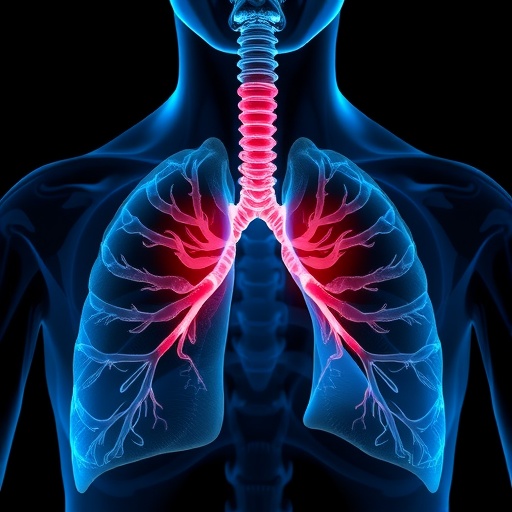Traditional methods for COPD assessment often rely on spirometry tests that require specialized equipment and clinical settings, limiting accessibility especially in low-resource areas. The pressing need for early detection tools that are both affordable and easy to deploy has driven the research community to explore alternative diagnostic avenues. The study in question exploits the ubiquity of smartphones to record exhalation and cough sounds, subsequently analyzing these acoustic biomarkers through sophisticated machine learning algorithms. This paradigm shift could democratize screening efforts, enabling broad reach even in remote populations.
.adsslot_Jwv9KY3i8W{width:728px !important;height:90px !important;}
@media(max-width:1199px){ .adsslot_Jwv9KY3i8W{width:468px !important;height:60px !important;}
}
@media(max-width:767px){ .adsslot_Jwv9KY3i8W{width:320px !important;height:50px !important;}
}
ADVERTISEMENT
Central to the study was the implementation of the XGBoost algorithm, a powerful gradient boosting machine learning model renowned for its accuracy and efficiency. With this approach, the analysis of exhalation and cough audio signals achieved a remarkable precision of 0.98 and a recall of 0.89 in identifying individuals at risk of COPD. These metrics indicate a high degree of reliability, minimizing false positives while capturing the majority of true cases, which is critical for effective screening protocols.
One of the pivotal findings of this research is the complementary value of cough sounds in conjunction with exhalation signals. While previous investigations predominantly focused on passive breathing patterns, the incorporation of cough audio enriches the diagnostic landscape, providing deeper insights into airway changes characteristic of COPD. The intricate acoustic features extracted from these cough recordings reveal subtle variations that correlate with pulmonary function decline, thereby augmenting the predictive power of the models.
Beyond technical performance, the practicality of the proposed method stands out. Smartphone-based recording circumvents the need for specialized medical devices, allowing for non-invasive, rapid, and user-friendly data collection. This could facilitate large-scale screening campaigns without the logistical constraints typically associated with spirometry. Moreover, integrating machine learning analytics into mobile platforms holds promise for real-time risk assessment, offering immediate feedback to users and healthcare providers alike.
The researchers emphasize the significance of their findings in the context of resource-limited settings, where COPD burden remains disproportionately high but diagnostic services are scarce. The accessibility and affordability of smartphone technology combined with this novel algorithmic assessment tool could lead to earlier interventions, improved patient outcomes, and reduced healthcare expenditures worldwide. Such innovations align with global health equity goals, ensuring that vulnerable populations gain access to essential respiratory care.
Importantly, the research opens avenues for further exploration, such as extending this approach to monitor disease progression, predict exacerbations, or evaluate treatment efficacy. With continuous advancements in artificial intelligence and mobile technology, integrating multimodal data streams—combining audio with physiological sensors or self-reported symptoms—could yield even more nuanced and personalized respiratory assessments.
The implications of this study reverberate beyond COPD alone. The methodology underscores the vast diagnostic potential embedded in everyday biosignals and the transformative role of machine learning in extracting meaningful health insights from them. This advancement heralds a future where remote, non-invasive health monitoring becomes standard practice, empowering individuals to take proactive control over their respiratory health.
As the world contends with an aging population and rising prevalence of chronic respiratory diseases, innovations like this stand testament to the power of interdisciplinary research catalyzing medical breakthroughs. Harnessing the ordinary act of breathing and coughing through extra-ordinary analytics, the study not only charts a new course for COPD risk detection but also exemplifies the growing synergy between biomedical engineering and global health.
The publication has garnered attention for its elegant fusion of technology and medicine, charting a scalable path toward improved public health surveillance. It underscores how leveraging ubiquitous devices like smartphones can unlock previously untapped reservoirs of health data, transforming clinical paradigms and enabling precision medicine approaches in everyday settings.
Subject of Research: Chronic obstructive pulmonary disease (COPD) risk assessment using exhalation and cough sounds.
Article Title: Assessing chronic obstructive pulmonary disease risk based on exhalation and cough sounds.
Article References: Wen, G., Wang, C., Zhao, W. et al. Assessing chronic obstructive pulmonary disease risk based on exhalation and cough sounds. BioMed Eng OnLine 24, 82 (2025). https://doi.org/10.1186/s12938-025-01420-6
Image Credits: AI Generated
DOI: https://doi.org/10.1186/s12938-025-01420-6
Tags: accessible COPD screeningacoustic biomarkers for lung healthbreath sound analysisChronic obstructive pulmonary disease researchCOPD risk assessmentcough sound evaluationearly detection of COPDinnovative respiratory healthcarelow-resource healthcare solutionsmachine learning in healthcarerespiratory sound data collectionsmartphone-based diagnostics




